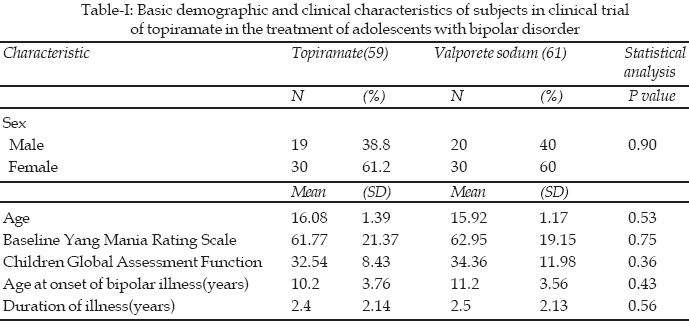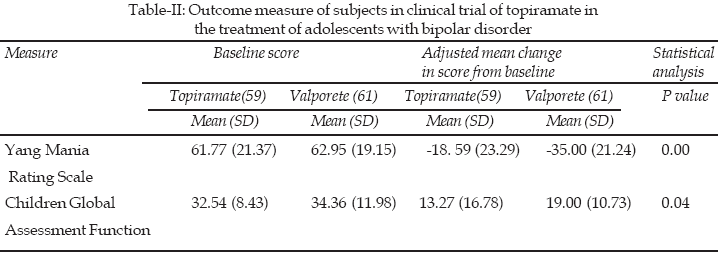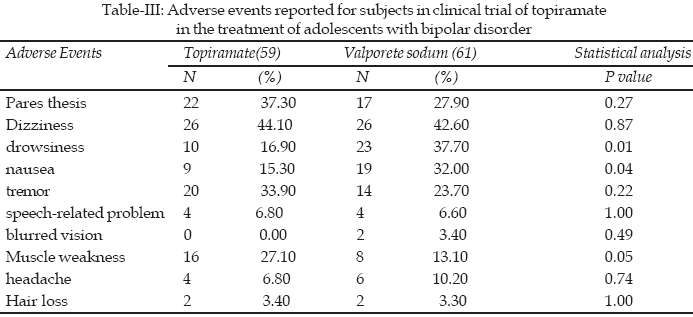|
|
||||
|
Published by : PROFESSIONAL MEDICAL PUBLICATIONS |
||||
|
ISSN 1681-715X |
||||
|
||||
|
- |
||||
|
ORIGINAL ARTICLE |
||||
|
- |
||||
|
Volume 25 |
April - June 2009 (Part-I) |
Number 2 |
||
|
|
||||
|
||||
|
|
||||
|
Published by : PROFESSIONAL MEDICAL PUBLICATIONS |
||||
|
ISSN 1681-715X |
||||
|
||||
|
- |
||||
|
ORIGINAL ARTICLE |
||||
|
- |
||||
|
Volume 25 |
April - June 2009 (Part-I) |
Number 2 |
||
|
|
||||
|
||||
Double-blind, randomized, clinical trial of topiramate
versus sodium valproate for the treatment of
bipolar disorder in adolescents
Paria Hebrani1, Fatemeh Behdani2, Ali Akhoondpoor Manteghi3
ABSTRACT
Objective: To study the efficacy and safety of Topiramate versus Sodium Valproate for the Treatment of Bipolar Disorder in Adolescents
Methodology: One hundred twenty adolescents (aged 12-18) with an admission diagnosis of bipolar I disorder, manic or mixed episode were enrolled from the Adolescent Ward at Ebn-e-Sina Psychiatric Center of Mashhad University. They were assigned to receive 8 weeks of double-blinded, flexibly dosed treatment with topiramate or sodium valproate. The primary efficacy measure was the mean change from baseline to endpoint in the Young Mania Rating Scale (YMRS).
Results: Sodium Valproate was superior to topiramate. The YMRS scores decreased significantly in both groups. However, when efficacy of topiramte was analyzed, only 18.64% of the patients showed YMRS scores decrease more than 50% from baseline.
Conclusions: This study does not support the efficacy of topiramate as monotherapy in acute mania or mixed episodes in adolescents with bipolar I disorder and sodium valproate was found superior to topiramate.
KEY WORDS: Bipolar, Child and Adolescent, Topiramate, Sodium valproate.
Pak J Med Sci April - June 2009 Vol. 25 No. 2 247-252
How to cite this article:
Hebrani P, Behdani F, Manteghi AA. Double-blind, randomized, clinical trial of topiramate versus sodium valproate for the treatment of bipolar disorder in adolescents. Pak J Med Sci 2009;25(2):247-252.
1. Paria Hebrani,
Child & Adolescent Psychiatrist, Associate Professor,
2. Fatemeh Behdani,
Psychiatrist, Associate Professor,
3. Ali Akhoondpoor Manteghi,
Psychiatrist, Assistant Professor,
1-3: Department of Psychiatry,
Mashhad University of Medical Sciences,
Mashhad – Iran.
Correspondence
Paria Hebrani,
Horre Ameli Street,
Ebn-E- Sina Hospital,
Mashad,Iran.
Email: hebranip@mums.ac.ir
* Received for Publication: June 23, 2008
* Revision Received: July 11, 2008
* 2nd Revision Received: November 11, 2008
* Final Revision Accepted: January 25, 2009
INTRODUCTION
Bipolar disorder in children and adolescents is a serious illness,
1 with poor outcome and adverse effects that influence social, family, and academic functioning.2 Bipolar disorder in youth tends to be chronic with atypical and mixed features.3Anticonvulsants, lithium, and atypical antipsychotics are frequently used to treat this disorder in children.
4 But 50% or more of the patients don’t respond thoroughly.5,6 Topiramate is a novel anticonvulsant that inhibits brain glutamate release, attenuates activity at Na+ channels and high-voltage- activated Ca2+ channels.7 It also increases cerebral (GABA) concentration.8Each of these mechanisms may be of therapeutic benefit for manic symptoms of BMD.
9Despite previous trials in which manic hospitalized adults showed no efficacy of topiramate as monotherapy,
10 a number of open and retrospective studies have reported that topiramate may be a promising alternative to traditional mood stabilizers (MS) in the treatment of mania. It was found that topiramate is effective in the short-term treatment of bipolar mania as either a combination regimen or as a monotherapy.11-14Pediatric bipolarity may co-occur with other disorders such as ADHD, conduct disorder and other conditions that make their response different from adults,
15 so the results of adult trials would not be generalized to pediatric bipolar patients. Delbello reported that topiramate has been found to be useful in pediatric patients.16,17A pilot controlled study of topiramate for mania in children and adolescents with bipolar disorder has been done by Delbello that couldn’t show the effectiveness of topiramate in pediatric bipolar disorder.
18 Because of premature termination of the Delbello study, it seems that more controlled trials are necessary to determine the efficacy of topiramate in reducing symptoms of acute mania in children and adolescents.In this study we conducted a double blind controlled trial to compare the effectiveness of sodium valproate and topiramate as monotherapy, in acutely manic children and adolescents with bipolar disorder.
METHODOLOGY
This study was an 8-week, double-blind, randomized clinical trial of comparison between topiramate and sodium valproate for the treatment of adolescent mania. One hundred twenty adolescents (aged 12-18) with an admission diagnosis of bipolar I disorder, manic or mixed episode were enrolled from the Adolescent Ward at Ebn-e-Sina Psychiatric Center of Mashhad University from September 2004 to September 2007.
At the time of admission all the patients met the full criteria for bipolar disorder [based on Diagnostic and Statistical Manual of Mental Disorders, fourth edition, text revised (DSM-IV-TR)]. The psychiatric assessment of the probands relied on the Persian version of Schedule for Affective Disorders and Schizophrenia for School-Age Children—Epidemiologic Version (K-SADS-E).
19 Diagnosis was based on an independent interview with the parents and probands. The raters were trained and supervised by board-certified psychiatrists.The interviewers were blind to probands diagnosis. The direct interview of mothers and the direct interview of the children were conducted by different raters and their responses were combined to ascertain diagnosis. The psychiatrists making the diagnoses were board-certified in both child and adult psychiatry. Demographic information was obtained by interviewing the patients and their primary caregivers. To be included in this study, patients were required to have a Young Mania Rating Scale (YMRS); score of >=20 at baseline.
20Exclusion Criteria:
Substance use disorder (other than nicotine) within the previous three months; unstable medical or neurological illness; history of intolerance or no response to topiramate or sodium valproate monotherapy; ongoing treatment with an antidepressant or an anticonvulsant (other than as noted below) within four weeks or an antipsychotic or psychostimulant within last 48 hours. Patients who were receiving treatment with lithium, valproate, or carbamazepine , were required to have undetectable serum concentrations (=0.4mEq/L, =30µg/mL, and =4µg/mL, respectively) before entering the study, to ensure an adequate washout period. The use of lorazepam to reduce agitation or insomnia during the study (a maximum of 4 mg/day for days 0-7 and 2 mg/day for days 8-14) was permitted.The study was conducted in accordance with the Declaration of Helsinki. All subjects and their parents or legal guardian (advocate) gave written informed consent for participation. Subjects could withdraw any time during the study (if the patients or their legal advocate no longer wanted to continue).
Study Medication:
After meeting all the inclusion and exclusion criteria, patients were randomly assigned to topiramate or sodium valproate groups. Medications were prescribed in a double-blind manner. Specifically, all investigational staff members who performed efficacy and tolerability rating scales were blind to the patient treatment group. Topiramate group patients received a dose of 50mg on day 0; every two days the dose was increased by 50mg and based on tolerability, the maximum dose (400 mg/day) was reached by day seven. After complete titration, subjects were maintained on a stable dose through 8 weeks. Patients in sodium valproate group received an initial dose of 200 – 400 mg in the evening (5-7 PM) on day 0. Every 2 days the dose was increased by 200-400 mg; based on tolerability, the maximum dose was increased to 1200mg by day seven. No patient was released because all could tolerate these minimum dose requirements. Two psychiatrists who were not blind to the treatment status of patients and who did not perform efficacy or tolerability ratings monitored the clinical signs, symptoms, and adverse effects of treatments and adjusted the dose of topiramate and sodium valproate.The primary efficacy measure was a change in total YMRS score from baseline to day 56 or endpoint. Secondary efficacy measure included: children’s global assessment scale.
21 Primary and secondary efficacy assessments were performed on days 0, 3, 7, 14, 28, and 56 by raters who were blind to treatment group status and tolerability assessments.Statistical Analysis: It was estimated that 60 patients in each group would be sufficient to detect a mean difference of 8 between groups (change in YMRS total score from baseline to the endpoint), based on a standard deviation of 13. This means the difference is detectable with a power of 90%, given a significance level of 5% using a two-sided t test. Efficacy analyses were performed in the intent-to-treat population, which was defined as subjects who took study medication and had at least one post baseline efficacy measure. Statistical analyses include chi2 or Fisher exact analyses and t tests to compare demographic and baseline clinical variables between treatment groups, independent sample T-test used for between two-group comparisons and paired sample T-test for within-group comparisons.
RESULTS
Out of 150 patients screened, 142 patients were randomly assigned to double-blind treatment with either topiramate (N=71) or sodium valproate (N=71). The others withdrew from the study before any post randomization data were collected. Thus, the efficacy analysis included 61 patients in the sodium valproate group and 59 in the topiramate group.

Baseline demographic and clinical characteristics for the two groups are summarized in Table-I. No statistically significant differences were observed between the two groups on any of the characteristics. Mean baseline scores on the YMRS, and the CGAF were also similar. The ratios of male to female, duration of illness are similar in both groups. Table-II shows outcome measure for the two groups at the last assessment visit. Differences between groups in adjusted mean change were statistically significant.

There was a statistically significant difference in YMRS score from baseline to endpoint between groups and sodium valproate was superior to topiramate. There was a statistically significant difference in CGAF score from baseline to endpoint between groups and sodium valproate was superior to topiramate. Mean YMRS scores decreased among patients in both topiramate and sodium valproate groups from baseline to endpoint. Increased mean total scores on the CGAF from baseline to endpoint were also noted for both the topiramate and sodium valproate groups.
Although topiramate group showed differences between baseline score and at the end of study in YMRS and CGAF, the mean score at weak 8 didn’t indicate improvement because in 81.36% of the patients decrease was less than 50% from baseline.
Overall, 72(60%) patients experienced one or more adverse events; the incidence of adverse events were similar in both groups and also there were no statistically significant differences in experiencing adverse events between them. Drowsiness and nausea were significantly reported in valproate sodium group; muscle weakness was more reported in topiramate group but was not significant. The most adverse effects in topiramate group were dizziness, paresthesia, and tremor and muscle weakness (Table-III).

DISCUSSION
This study compared the effectiveness and tolerability in patients with bipolar mania who received topiramate and sodium valproate over eight weeks in which sodium valporate was proved to topiramate. In this study, the YMRS scores decreased significantly in both groups. However, when efficacy of topiramte was analyzed, it showed that the mean score at 8th weak didn’t indicate improvement, because only 18.64% of the patients showed YMRS scores decrease more than 50% from baseline. These data suggested a possible effect, perhaps modest in some of children and adolescents with bipolar disorders.
The efficacy of sodium valproate is in accordance with other children
1,22-25 and adult trials.5The results about topiramate as monotherapy in bipolar disorder are controversial and some indicated the modest efficacy of topiramate in adult trials.
11-13 Trials in children and adolescents are so limited and the results of efficacy of topiramate as monotherapy are inconsistent.16-18 Topiramate therapy was tolerated well in this study; only three subjects in topiramate group discontinued treatment early, owing to an adverse effect. The most commonly reported adverse effect during topiramate therapy were dizziness, paresthesia ,tremor and muscle weakness, and somnolence which are consistent with the established tolerability profile of topiramate in children.26The main strength of this study is that it is the first comparative study of 8- week, double-blind, randomized study of topiramate versus sodium valproate for the treatment of adolescent mania. Our study had following
Limitations of this study: Sample selection from inpatient subjects which represent more severe cases and might be refractory to different types of treatment. Bipolar disorder in juvenile may co-occur with disorders of impulse control, specifically ADHD and conduct disorder.
Therefore, these comorbidities can influence the efficacy of treatment, although we didn’t determine these comorbid disorders. Therefore, it is important to evaluate treatment options for BPD in juvenile with considering a spectrum of types of bipolarity with different types of comorbidities. So, we should consider these limitations when interpreting the results.
CONCLUSION
This study demonstrated that divalproex is superior to topiramate, and even though topiramate may decrease the scores on YMRS, it doesn’t show improvement. Both of them are tolerable for treating bipolar mania. Further studies with a controlled design are proposed.
REFERENCES
1. Geller B, Zimmerman B, Williams M, Bolhofner K, Craney JL, DelBello MP, et al. Diagnostic characteristics of 93 cases of prepubertal and early adolescent bipolar disorder phenotype by gender, puberty and comorbid attention deficit hyperactivity disorder. J Child Adolesc Psychopharmacol 2000;10:157-64.
2. Perlis RH, Miyahara S, Marangell LB. Long-term implications of early onset in bipolar disorder: data from the first 1000 participants in the systematic treatment enhancement program for bipolar disorder (STEP-BD). Biol Psychiatry 2004;55:875-81.
3. Craney JL, Geller B. A prepubertal and early adolescent bipolar disorder-I phenotype: review of phenomenology and longitudinal course. Bipolar Disorders 2003;5:243-56.
4. Wagner KD. Management of bipolar disorder in children and adolescents. Psychopharmacol Bull: 2002a;36:151-9.
5. Bowden CL, Brugger AM, Swamm AC. Efficacy of divalproex vs. lithium and placebo in the treatment of mania. JAMA 1994;271:918-24.
6. Sachs GS, Grossman F, Ghaemi SN, Okamoto A, Bowden CL. Combination of a mood stabilizer with risperidone or haloperidol for treatment of acute mania: a double-blind, placebo-controlled comparison of efficacy and safety. Amer J Psych 2002;159:1146-54.
7. Gibbs JW 3rd, Sombati S, DeLorenzo RJ, Coulter DA. Cellular actions of Topiramate: blockade of kainite-evoked inward currents in cultured hippocampal neurons. Epilepsia: 2000;41:(supplement1)S10-S16.
8. Kuzniecky R, Hetherington H, Ho S, Pan J, Martin R, Gilliam F. Topiramate increases cerebral GABA in healthy humans. Neurology 1998;51:627-9.
9. White HS. Mechanism of action of newer anticon-vulsants. J Clin Psychiatry 2003;64(suppl 8):5-8.
10. Kushner SF, Khan A, Lane R, HOlson W. Topiramate monotherapy in the management of acute mania: results of four double-blind placebo-controlled trials, Bipolar Disorders 2006;8:15-27.
11. Bozikas VP, Petrikis P, Kourtis A, Youlis P, Karavatos A. Treatment of acute mania with topiramate in hospitalized patients. Prog Neuro-psychopharmacol Biol Psychiatry 2002;26:1203-6.
12. Calabrese JR, Keck Jr, McElroy SL, Shelton, A pilot study of topiramate as monotherapy in the treatment of acute mania. J Clincal Psychopharmacology 2001;21:340-2.
13. Ghaemi SN, Manwani SG, Katzow JJ, Ko JY, Goodwin FK. Topiramate treatment of bipolar spectrum disorders: a retrospective chart review. Ann Clin Psychiatry 2001;13:185-9.
14. Guille C, Sachs G. Clinical outcome of adjunctive topiramate treatment in a sample of refractory bipolar patients with comorbid conditions. Prog Neuro-psychopharmacol Biol Psychiatry 2002;26:1035-9.
15. Wozniak J, Biederman J, Richards JA. Diagnostic and therapeutic dilemmas in the management of pediatric-onset bipolar disorder. J Clin Psychiatry 2001;62(suppl 14):10-15.
16. DelBello MP, Kowatch RA, Warner J. Adjunctive topiramate treatment for pediatric bipolar disorder: a retrospective chart review. J Child Adolesc Psychopharmacol 2002a;12:323-30
17. DelBello MP, Schwiers ML, Rosenberg HL, Strakowski SM. A double-blind, randomized, placebo-controlled study of quetiapine as adjunctive treatment for adolescent mania. J American Academy of Child & Adolescents Psychiatry 2002b;41:1216-23.
18. Delbello MP, Findling RL, Kushner S, Wang D, Olson WH, Capece JA. A Pilot Controlled Trial of Topiramate for Mania in Children and Adolescents with Bipolar Disorder. J Amer Academy Child Adolescent Psych 2005;44(6):539-47.
19. Ghanizadeh A, Mohammadi MR, Yazdanshenas A. Psychometric properties of the Farsi translation of the Kiddy Schedule for Affective Disorders and schizophrenia-Present and Lifetime Version. Bio Med Central Psychiatry 2006;6:10 20.
20. Young RC, Biggs JT, Ziegler VE, Meyer DA. A rating scale for mania: reliability, validity and sensitivity. Br J Psychiatry 1978;133:429-35.
21. Schaffer D, Gould MS, Brasic J. A children’s global assessment scale (CGAS). Archives General Psychiatry 1983;40:1228-31.
22. Wagner KD, Weller EB, Carlson GA. An open-label trial of divalproex in children and adolescents with bipolar disorder. J Amer Academy Child Adolescents Psychiatry 2002;41:1224-30.
23. Kowatch RA, Suppes T, Carmody TJ. Effect size of lithium, divalproex sodium and carbamazepine in children and adolescents with bipolar disorder. J Amer Academy Child Adolescents Psychiatry 2000;39:713-20.
24. Pavuluri MN, Henry DB, Carbray JA, Naylor MW, Janicak PG. Divalproex sodium for pediatric mixed mania: a 6-month prospective trial. Bipolar Disord 2005;7(3):266-73.
25. Rana M, Khanzode L, Karnik N, Saxena K, Chang K, Steiner H. Divalproex sodium in the treatment of pediatric psychiatric disorders, Expert Review of Neurotherapeutics: 2005;5(2):165-76.
26. Levisohn PM. Safety and tolerability of topiramate in children. J Child Neurol 2001;5(suppl 1):S22-S26.
HOME | SEARCH | CURRENT ISSUE | PAST ISSUES
Professional
Medical Publications
Room No. 522, 5th Floor, Panorama Centre
Building No. 2, P.O. Box 8766, Saddar, Karachi - Pakistan.
Phones : 5688791, 5689285 Fax : 5689860
pjms@pjms.com.pk